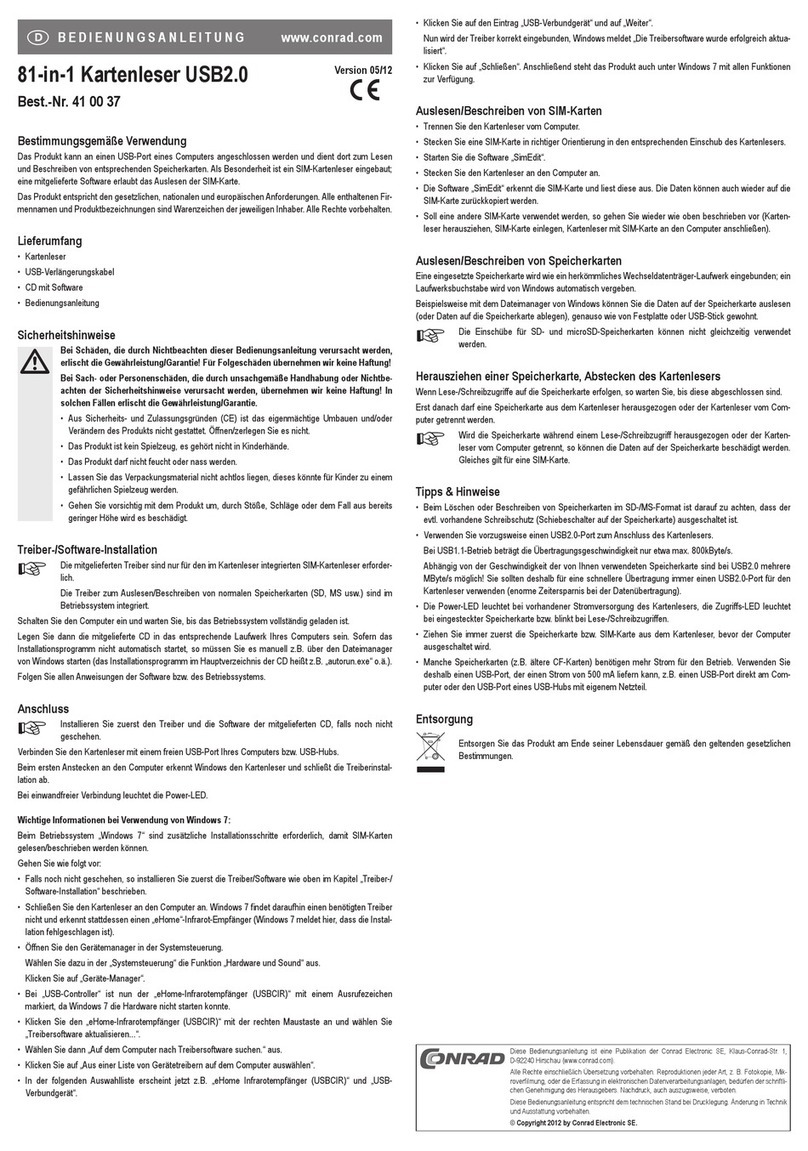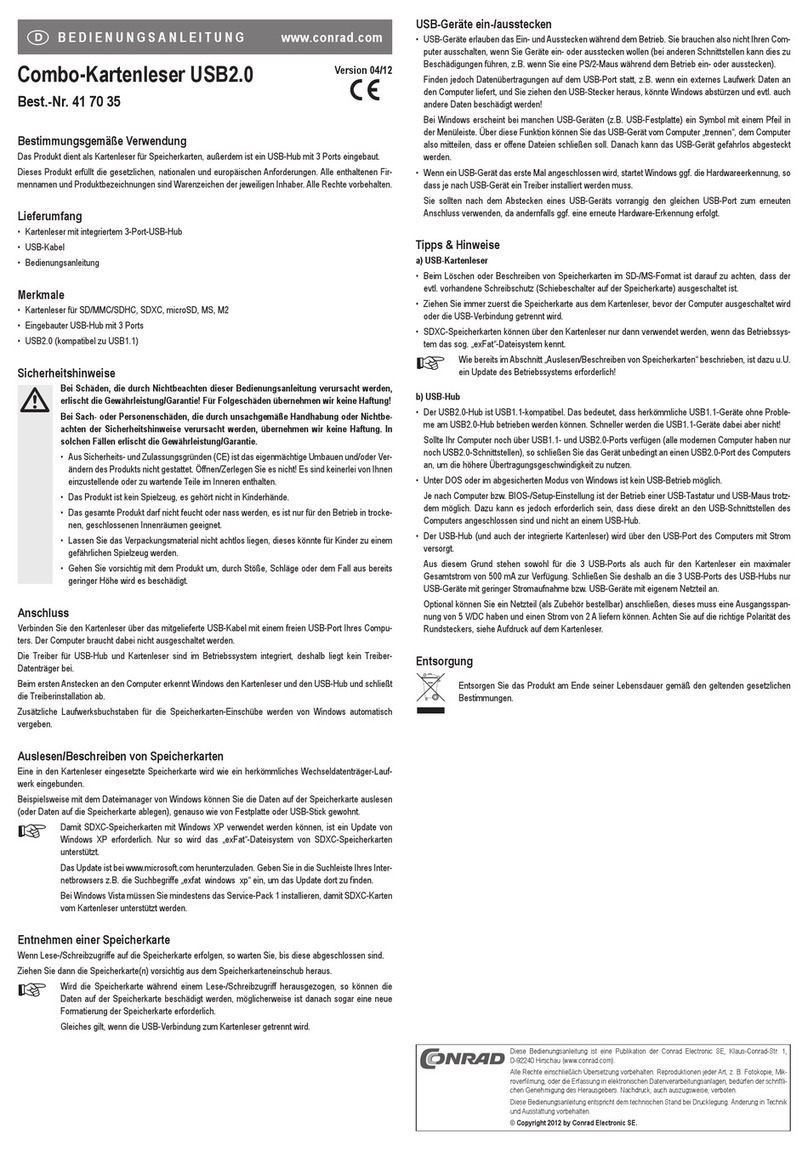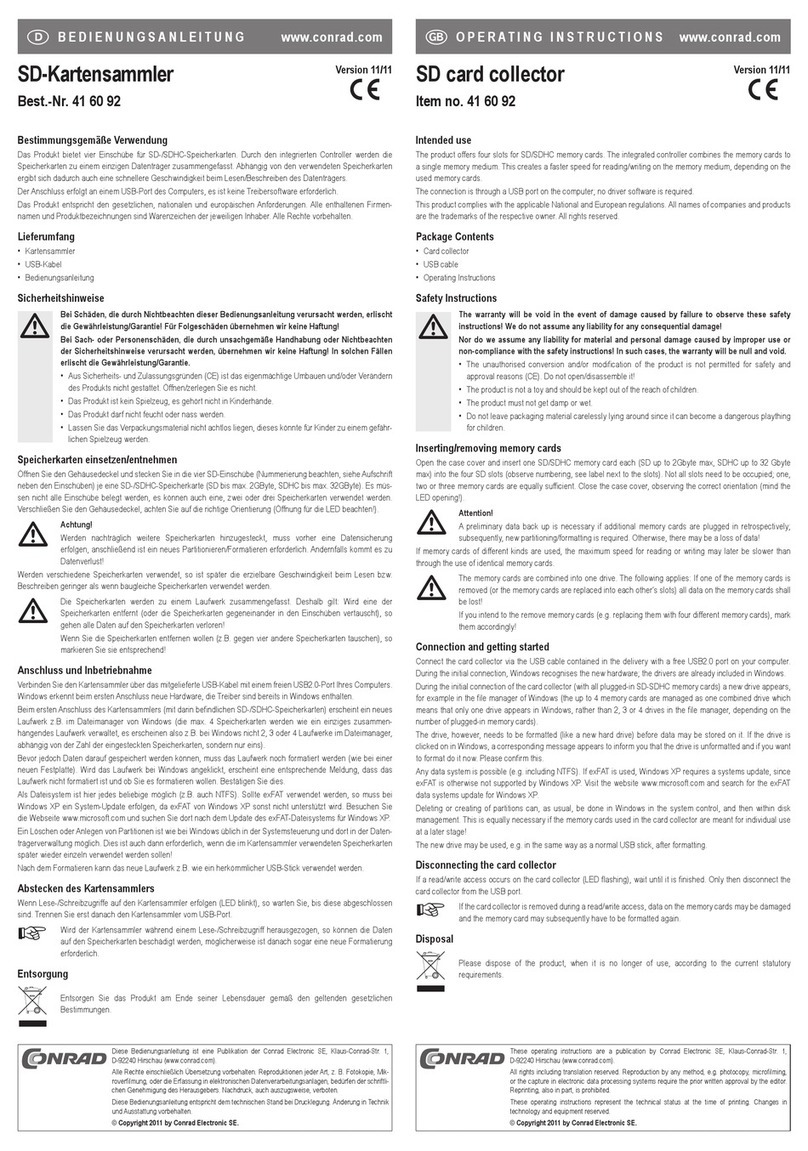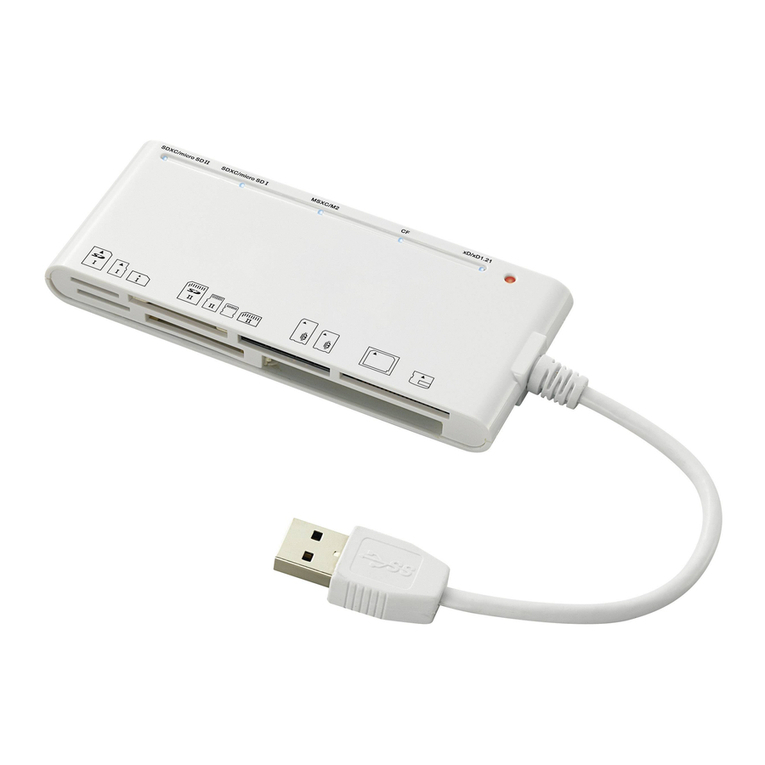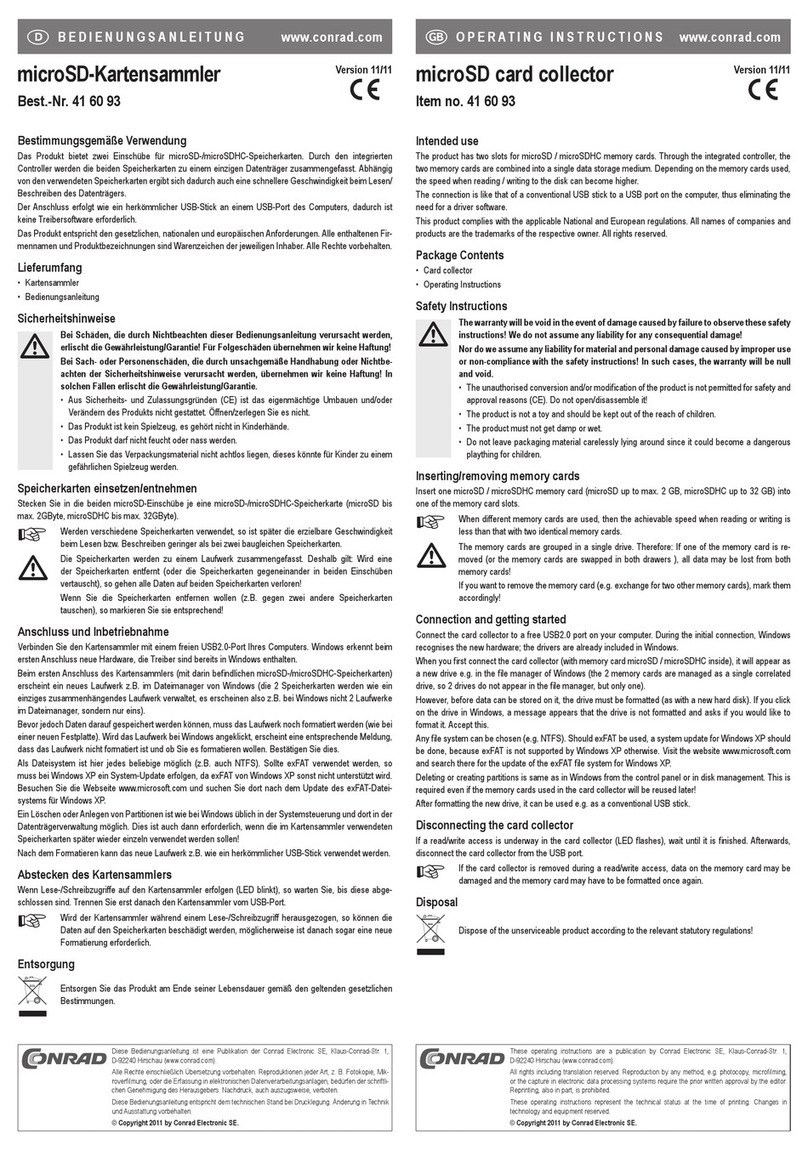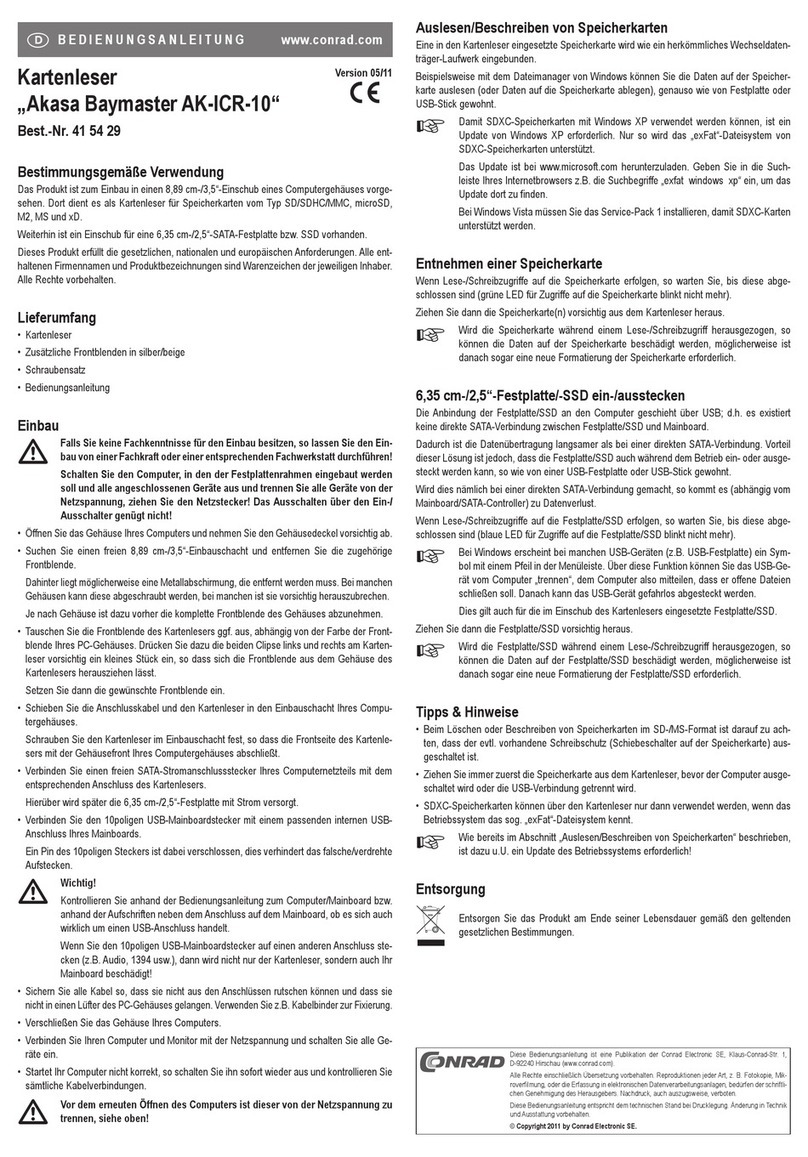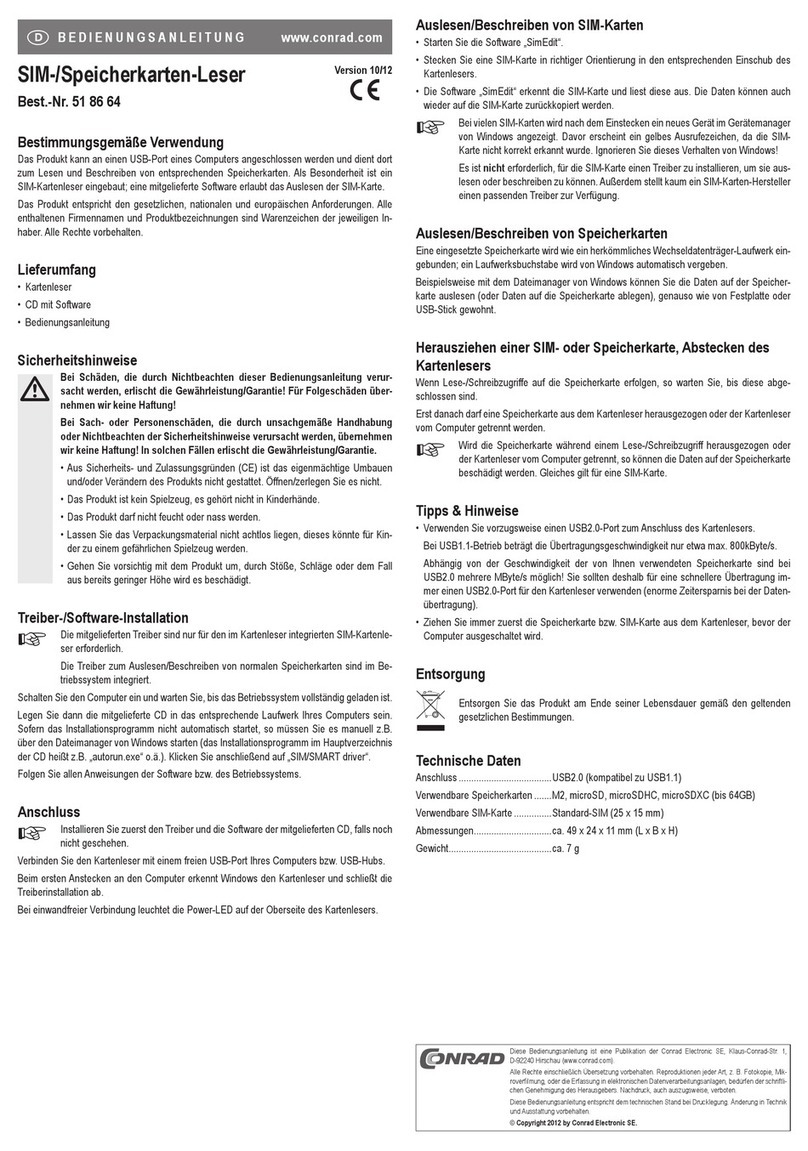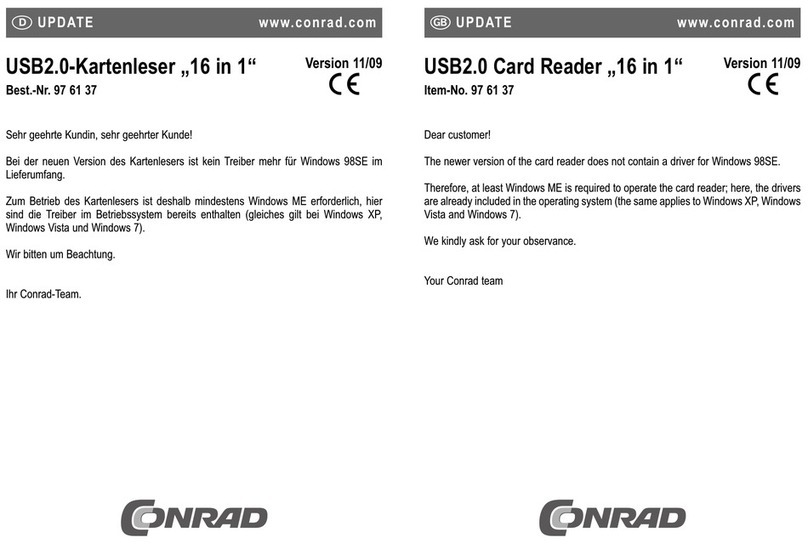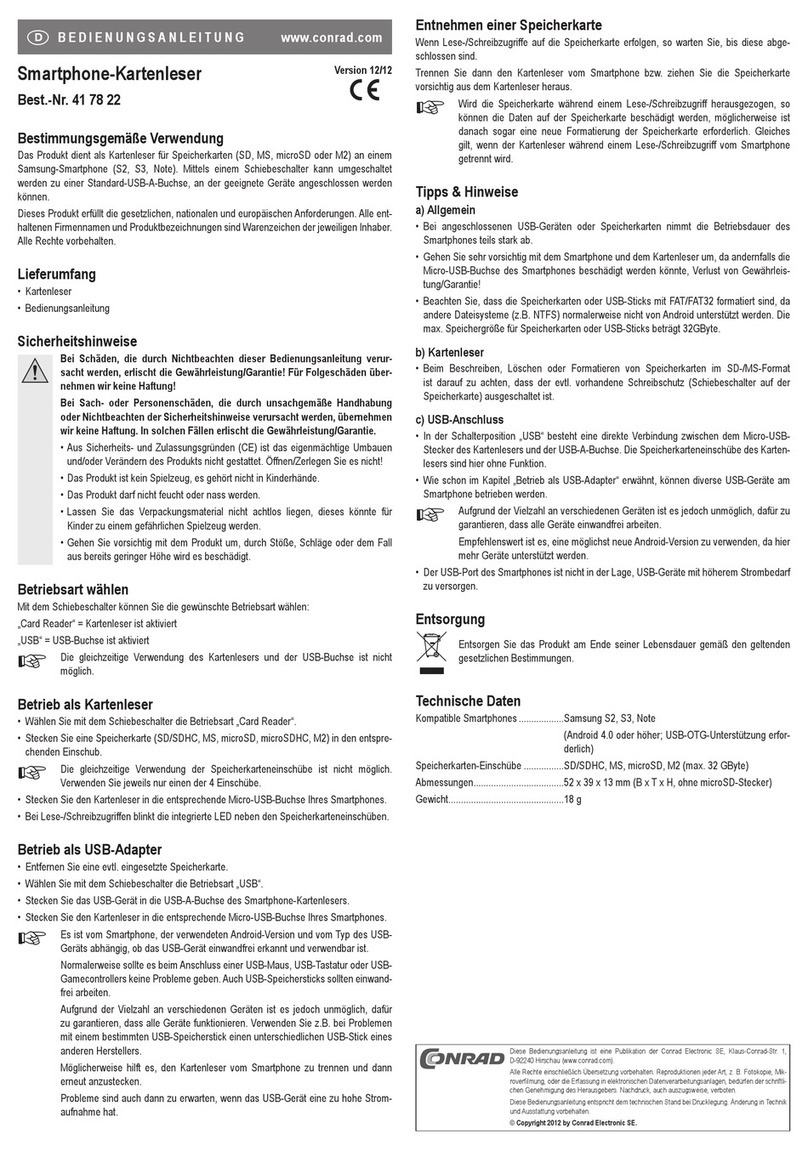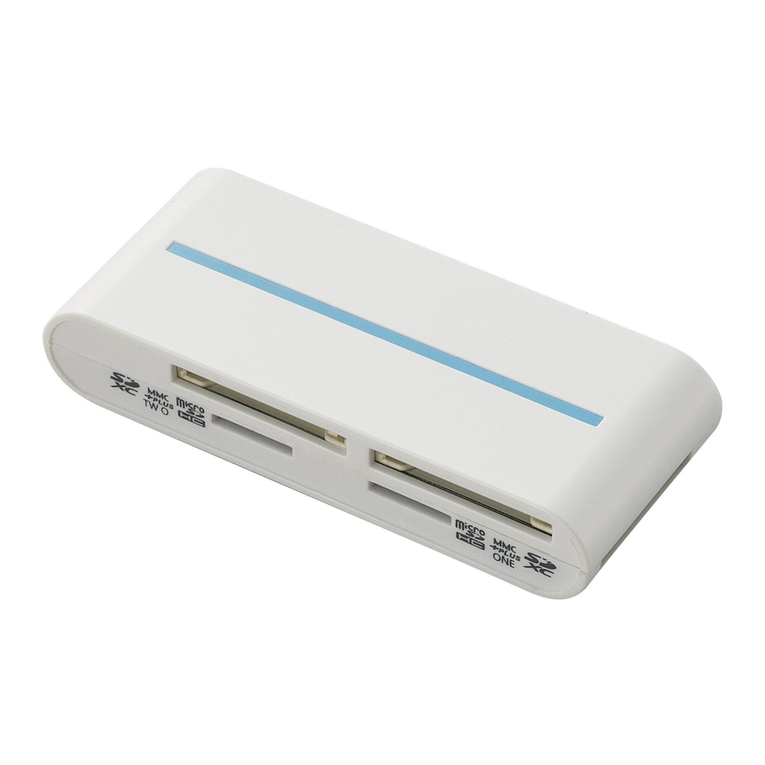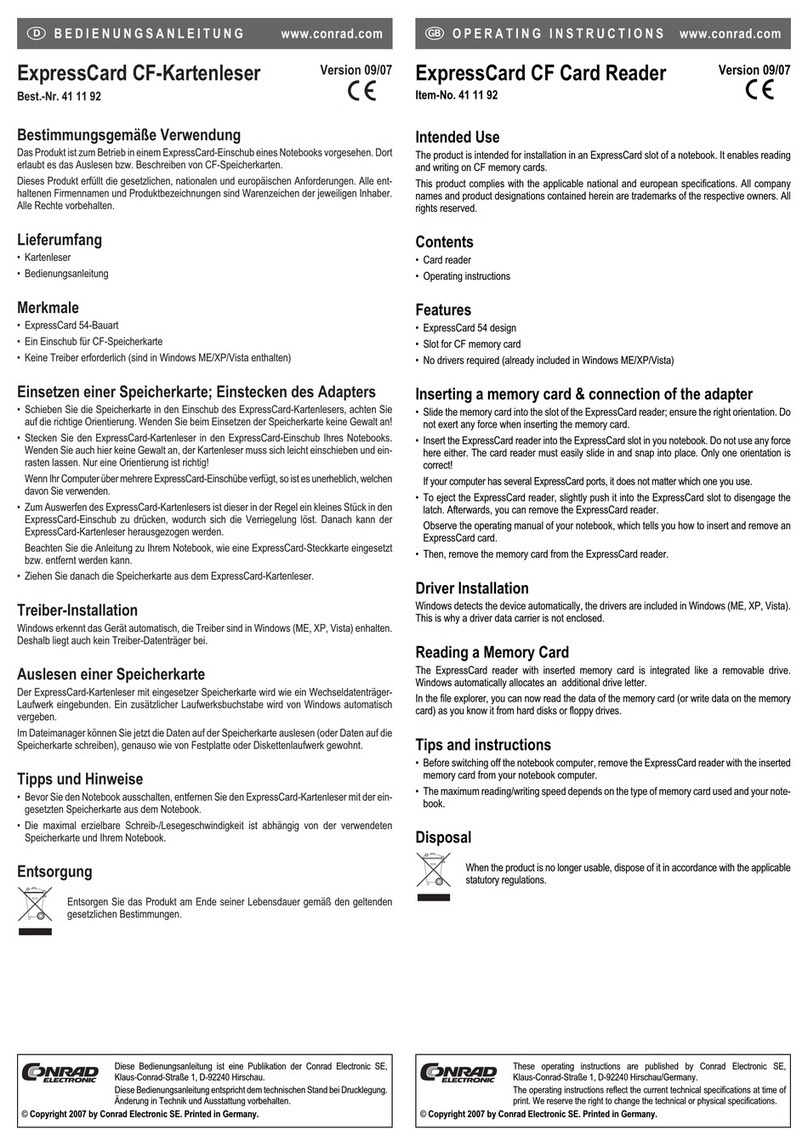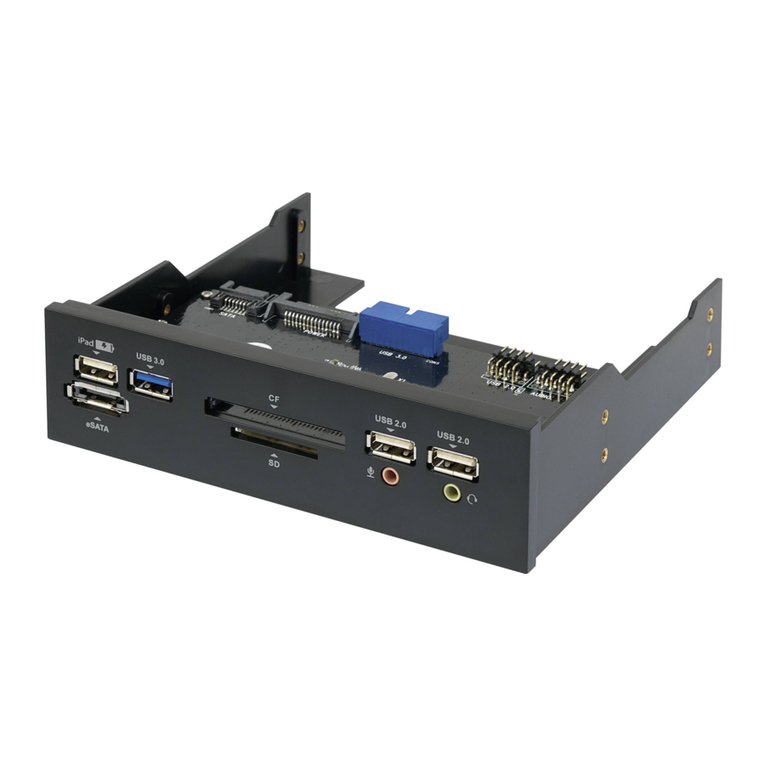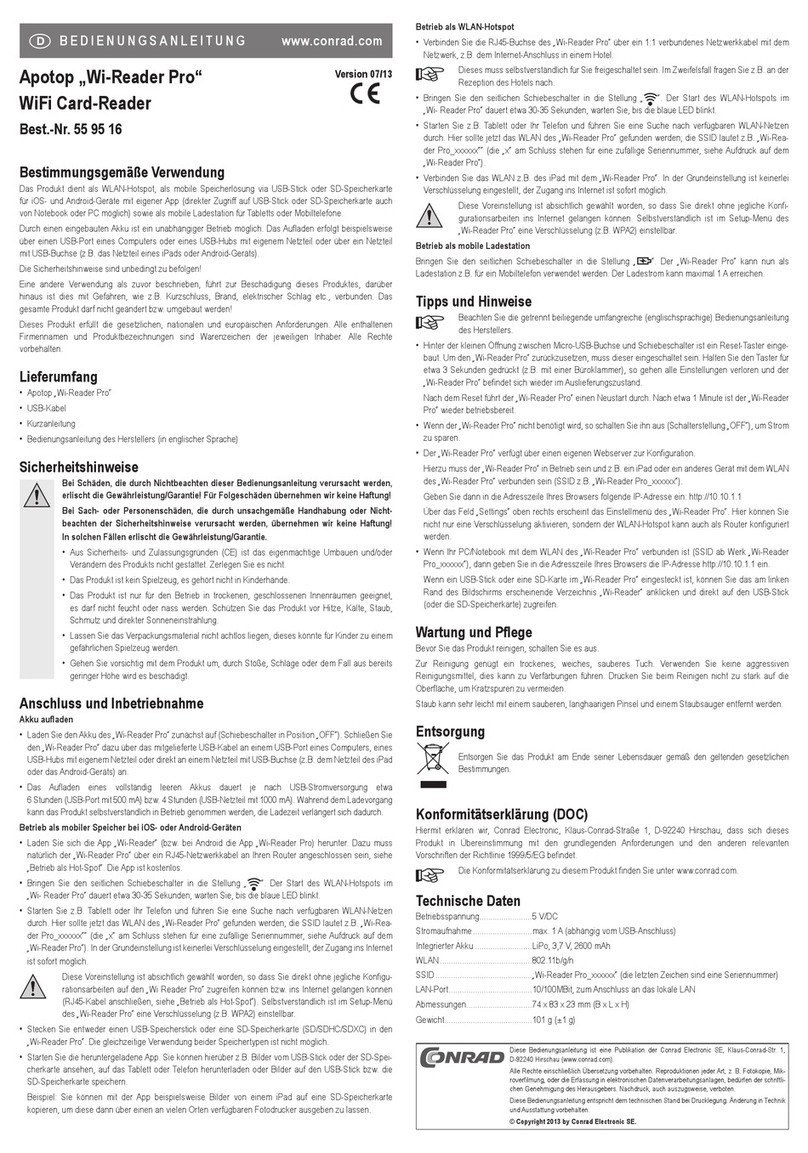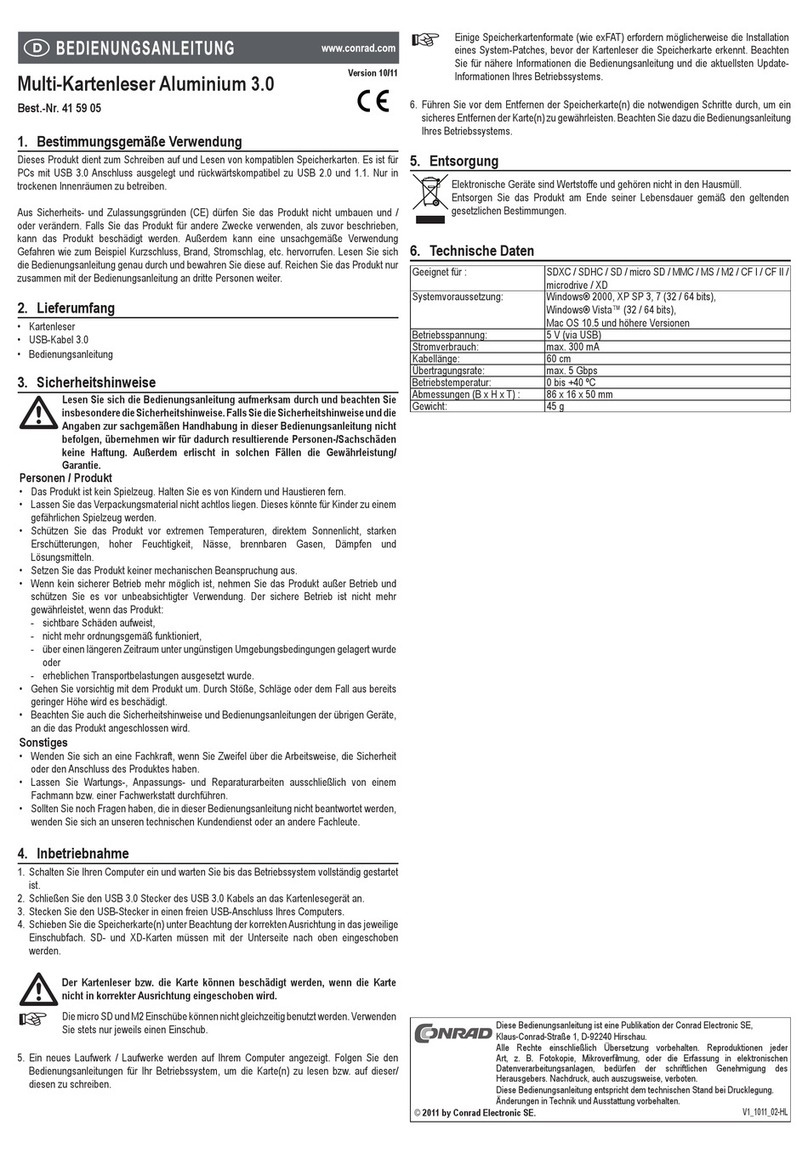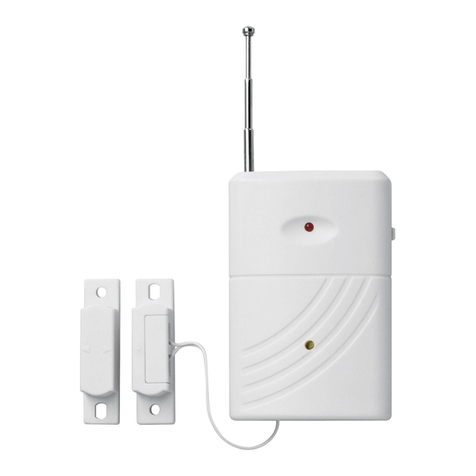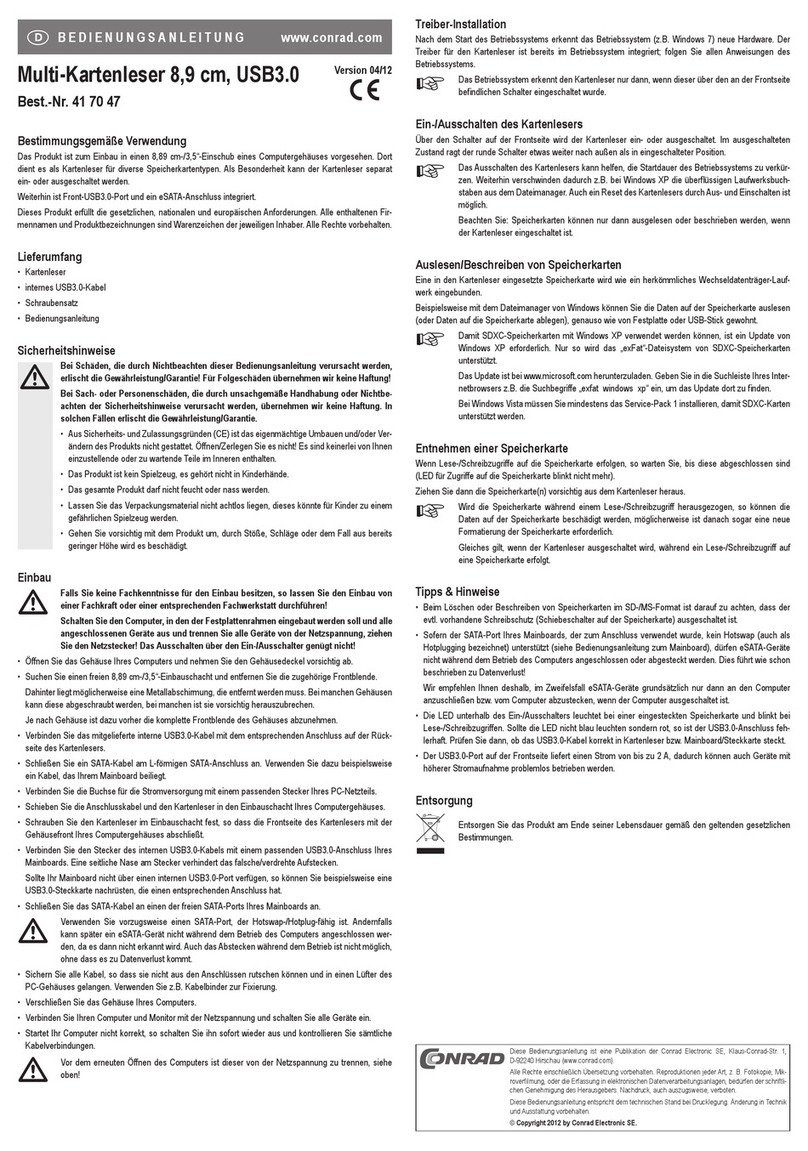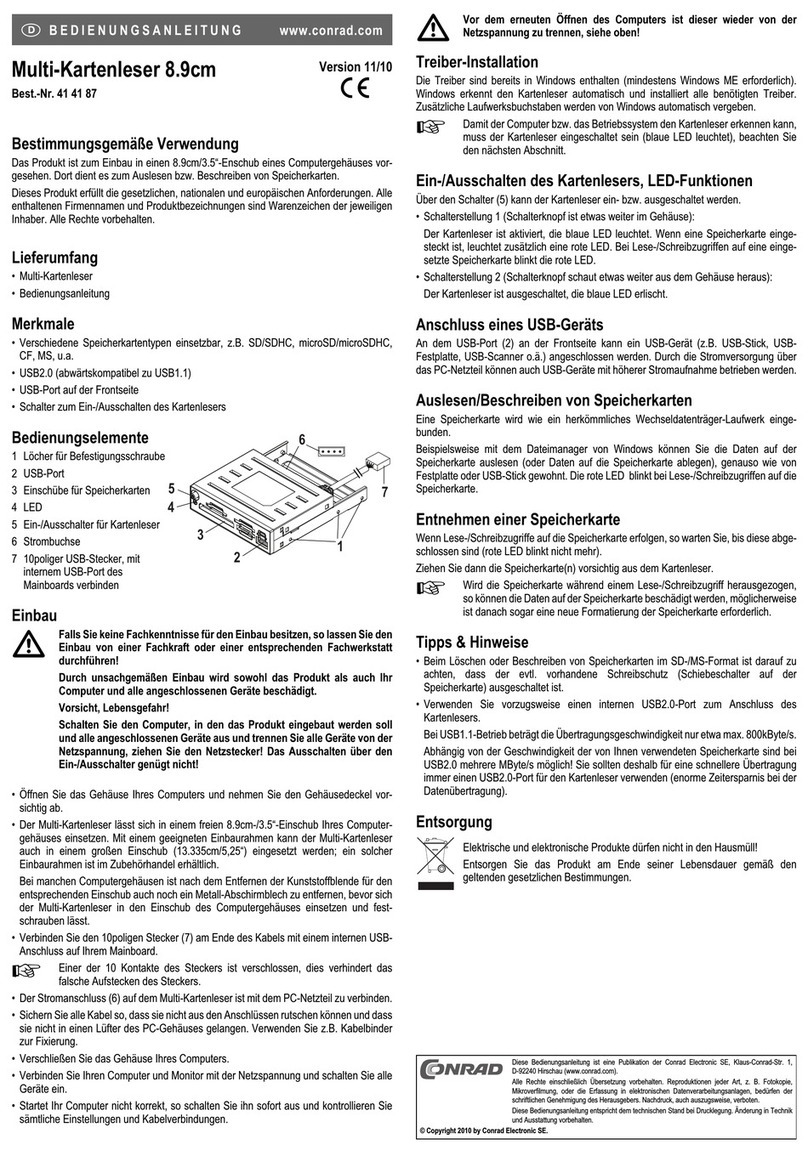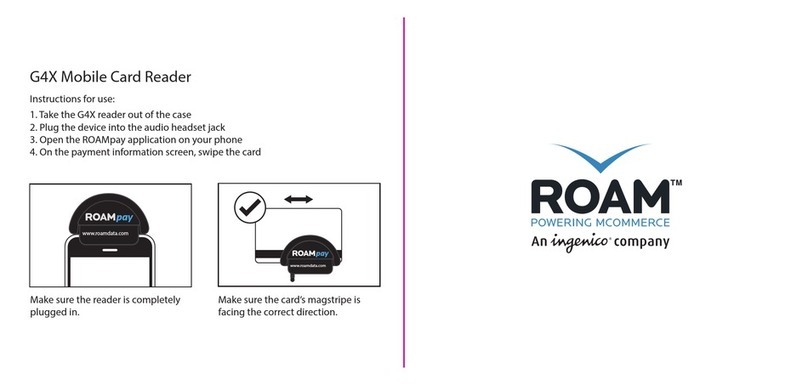
GEBRUIKSAANWIJZING www.conrad.com
PCMCIA cardreader 17in1
Bestelnr. 41 07 93
Correct gebruik
Het product is geschikt voor de aansluiting op een PCMCIA poort van een notebook. U kunt met de
cardreader geheugenkaarten van het formaat SD, SDHC, MMC, Memorystick en xD lezen en schrijven.
Alle firmanamen en productnamen zijn handelsmerken van de respectieve eigenaars. Alle rechten
voorbehouden.
Leveringsomvang
• PCMCIA cardreader
• Gebruiksaanwijzing
Kenmerken
• PCMCIA kaart type II
• Met gleuf voor een SD, SDHC, MMC, Memorystick of xD geheugenkaart
• Geen stuurprogramma´s noodzakelijk (deze zijn een onderdeel van Windows)
Geheugenkaart plaatsen en PCMCIA cardreader insteken
• Schuif de geheugenkaart in de betreffende gleuf van de PCMCIA cardreader. Let hierbij op de juiste
richting. Steek de geheugenkaart zonder geweld in de gleuf!
• Steek de cardreader correct in de PCMCIA poort van uw notebook. Doe ook dit zonder geweld. De
cardreader moet gemakkelijk in de poort geschoven kunnen worden en vastklikken. Er is enkel één
richting juist!
Als uw notebook meerdere PCMCIA poorten heeft, is het om het even welke poort u gebruikt.
• Om de cardreader weer te verwijderen beschikken de meeste notebooks over kleine knopjes naast de
PCMCIA poort. Raadpleeg de handleiding van uw notebook hoe PCMCIA kaarten geplaatst en
verwijderd worden.
• Trek daarna de geheugenkaart uit de cardreader.
Installatie van de stuurprogramma´s
Windows herkent het apparaat automatisch. De stuurprogramma´s zijn een onderdeel van Windows. Er
is daarom geen gegevensdrager met stuurprogramma´s meegeleverd.
Geheugenkaart lezen
De cardreader met de geplaatste geheugenkaart wordt zoals een gewoon verwisselbaar station
geïntegreerd. Een bijkomende stationsletter wordt automatisch door Windows toegekend.
In de verkenner kunt u nu de gegevens op de geheugenkaart lezen (of gegevens op de geheugenkaart
schrijven) net zoals bij uw harde schijf of een diskettestation.
Bij het wissen van bestanden van een SD of Memorystick geheugenkaart moet erop gelet worden dat de
schrijfbeveiliging van de kaart uitgeschakeld is.
Tips en wenken
• Vooraleer u de notebook uitschakelt, moet u de cardreader met de geplaatste geheugenkaart uit de
notebook nemen.
• De lees/schrijfsnelheid die maximaal bereikt kan worden is afhankelijk van de gebruikte geheugenkaart.
Verwijderen
Als het product niet meer werkt, moet u het volgens de geldende wettelijke bepalingen voor
afvalverwerking inleveren.
MODE D’EMPLOI www.conrad.com
Lecteur de cartes PCMCIA 17en1
N° de commande 41 07 93
Restrictions d’utilisation
Ce produit est prévu pour être utilisé au port PCMCIA d’un ordinateur portable. Là, le produit permet la
lecture et l’écriture des cartes-mémoire des formats SD, SDHC, MMC, Memorystick et xD.
Tous les noms d’entreprises et appellations de produits contenus dans ce mode d’emploi sont des
marques déposées des propriétaires correspondants. Tous droits réservés.
Contenu de l’emballage
• Lecteur de cartes PCMCIA
• Mode d’emploi
Caractéristiques
• Carte PCMCIA du type II
• Une baie pour une carte-mémoire SD, SDHC, MMC, Memorystick ou xD
• Des pilotes ne sont pas nécessaires (compris dans Windows)
Insertion d’une carte-mémoire & branchement de l’adaptateur PCMCIA
• Poussez la carte-mémoire dans la baie correspondante du lecteur de cartes PCMCIA et veillez à la
bonne direction. N’usez pas de force pour insérer la carte-mémoire !
• Branchez le lecteur de cartes PCMCIA au port PCMCIA de votre ordinateur portable. Pour cela, n’utilisez
également pas de force. Normalement, le lecteur de cartes PCMCIA est facile à pousser et à encliqueter.
Il n’y a qu’une seule direction correcte !
Si votre ordinateur est équipé de plusieurs ports PCMCIA, il est normalement sans importance lequel
des ports PCMCIA vous utilisez.
• Afin d’éjecter la carte PCMCIA, la plupart des ordinateurs portables est équipée de petits boutons
poussoirs à côté de la baie PCMCIA. Tenez compte du mode d’emploi de l’ordinateur portable pour
insérer ou enlever les cartes PCMCIA correctement.
• Enlevez ensuite la carte-mémoire du lecteur de cartes PCMCIA.
Installation des pilotes
Windows détecte automatiquement l’appareil. Les pilotes sont compris dans Windows. Pour cette raison,
un support de données pilote n’est pas compris dans l’emballage.
Lire une carte-mémoire
Le lecteur de cartes PCMCIA est utilisé comme un lecteur de supports de données interchangeables. Des
lettres de lecteur supplémentaires sont affectées automatiquement par Windows.
Dans l’explorateur de fichiers, vous pouvez maintenant lire les données de la carte-mémoire (ou écrire des
données sur la carte-mémoire) comme vous pouvez le faire avec une disque dur ou avec un lecteur de
disquettes.
Pour effacer les fichiers d’une carte-mémoire du type SD ou Memorystick, tenez compte du fait que la
protection contre l’écriture de la carte est désactivé.
Trucs & Astuces
• Avant d’éteindre l’ordinateur portable, enlevez le lecteur de cartes PCMCIA avec la carte-mémoire
insérée de l’ordinateur portable.
• La vitesse maximale de lecture/d’écriture dépend du type de la carte-mémoire utilisée.
Elimination des déchets
Jetez l´appareil devenu inutilisable suivant les lois en vigueur.
Version 10/09
Version 10/09
Ce mode d'emploi est une publication de la société Conrad Electronic SE, Klaus-
Conrad-Str. 1, D-92240 Hirschau (www.conrad.com).
Tous droits réservés, y compris de traduction. Toute reproduction, quelle qu'elle soit (p. ex. photocopie, microfilm, saisie
dans des installations de traitement de données) nécessite une autorisation écrite de l'éditeur. Il est interdit de le
réimprimer, même par extraits.
Ce mode d'emploi correspond au niveau technique du moment de la mise sous presse. Sous réserve de modifications
techniques et de l'équipement.
© Copyright 2009 by Conrad Electronic SE.
Dezegebruiksaanwijzingiseen publicatievan defirma ConradElectronic SE,Klaus-
Conrad-Str. 1, D-92240 Hirschau (www.conrad.com).
Alle rechten, vertaling inbegrepen, voorbehouden. Reproducties van welke aard dan ook, bijvoorbeeld fotokopie,
microverfilmingof de registratiein elektronischegegevensverwerkingsapparatuur, vereisen deschriftelijke toestemming
van de uitgever. Nadruk, ook van uittreksels, verboden.
Deze gebruiksaanwijzing voldoet aan de technische stand bij het in druk bezorgen. Wijziging van techniek en uitrusting
voorbehouden.
© Copyright 2009 by Conrad Electronic SE.

